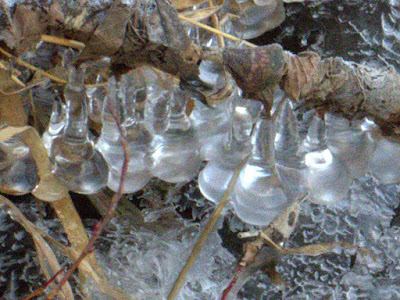I've finally been reading
The Big Year by Mark Obmascik. It's the story of three obsessive birders and their race to see the most species in North America in a year. The book inspired the Steve Martin/Jack Black/Owen Wilson film of the same name.
Early in the book the author describes one of the competitors, wealthy businessman Al Levantin, who kicks off his Big Year spotting mountain birds from skis in his home base of Aspen:
"That was the thing with Levantin: he loved the birds, but he really loved the places they brought him. When you spend your career in the confines of a gray suit, the pipits at dawn above timberline are even more wondrous. He lived to be in the field."
That rang so true for me that it practically leapt from the page, shimmering in gold.
~~~ He loved the birds, but he really loved the places they brought him. ~~~
I don't mean exotic new locations, though maybe someday birding will take me to some of those. I mean that my growing interest in birds has gently led me into the natural world, as well as into places that might also be described as states of mind:
the wondrousness of the pipits at dawn.
What are some places birding has taken me?
Outdoors.
Woods. Prairie. Trails. Ponds. Riverbanks.
The frozen Missisippi in winter, looking for bald eagles.
The first ice-free pond that hosts migrating ducks in the spring.
The Christmas Bird Count, spent driving slowly along rural roads looking for every single bird we can spot.
Barely leafed-out woods in May, looking and listening for warblers.
A driving trip up the Northern California coast: oystercatchers and thousands of marbled godwits.
A hilly hike in a Bay Area wilderness area, in search of golden eagles.
Sewage ponds. Yes, sewage ponds.
REI.
Good hiking shoes. Caps that shade the eyes. Quick-dry trousers with zip-off legs.
The idea that it's okay to invest modestly in some gear for what makes you happy.
Tentative experimentation with snowshoes.
Photography.
A better camera.
A huge proportion of this blog.
The Carleton Arboretum and River Bend Nature Center in all seasons.
The Minnesota Master Naturalist Class.
The Pothole and Prairie Birding Festival in North Dakota.
Plans to witness the sandhill crane migration in Nebraska this spring.
Listening. Looking. Scanning the sky or a body of water. Intently gazing into trees or shrubs.
And, at last, a new comfort being alone in a natural area. A sense of freedom and empowerment.
Let me say more about that last thing, because it's one of the biggies.
I lived mostly in large cities until moving to Northfield almost 25 years ago. I knew people who went hiking and backpacking and camping, and in fact my high school was quite into such things, but I didn't ever get much experience with those activities outside of organized groups, and though I admired people who did them, they didn't really call to me.
Also, in the city or outside it, I was always aware that danger might lurk in the bushes. And, terribly, there were reports of murdered hikers reinforcing the point.
Even when I got to this safe small town, my city instincts followed me. Maybe I didn't still carry my keys pointing out between my fingers when walking to my car at night, but a woman (especially a small, not particularly athletic woman) alone in a park or the woods or on a hiking trail was vulnerable. You didn't put yourself into that situation. At least, that's how it continued to feel to me.
Until I had enough reason to want to. And that's what the birds gave me.
It's taken me a long time to realize what I'd missed -- that sense of freedom and empowerment that I mentioned above -- and birding is what finally got me there. But it's not all about the birds anymore. Being out in the natural world has become intrinsically rewarding in a way it really wasn't for me, before.
I still don't feel called to feats of solo distance hiking like Cheryl Strayed, or my sister-in-law
Bethany who hiked the John Muir Trail solo in 2012. One of the things I've always said I like about birding is
it gets you outside without having to be too strenuous about it.
But an early morning hour or so wandering by myself in the Arb, River Bend, or other natural areas nearby, entirely at my own pace, choosing my route, camera and binoculars ready for whatever I may discover ... bliss.
Thank you, birds.



































